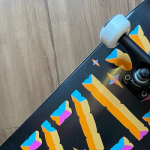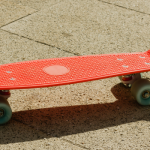The Ollie, a fundamental skateboard trick, is like the building block for tons of cool moves.
You’ve probably seen it done on regular skateboards, but here’s the thing – once you nail the Ollie on a cruiser or longboard, a whole new world of possibilities opens up.
It’s all about that smooth, relaxed cruising style. So, in this article, we’re gonna break down the step-by-step process of pulling off an Ollie on a cruiser or longboard.
I’ll give you all the deets and some insider tips to help you become a master of this awesome trick.
Get your board ready, ’cause we’re about to take your skateboarding skills to the next level on this epic journey of Ollie mastery.
Understanding the Basics:
Before we get into the nitty-gritty details of how to Ollie on a cruiser or longboard, let’s first understand what sets them apart from traditional skateboards.
Cruisers are typically shorter and have kicktails – the upward curved ends of the board. They also usually have wider decks, larger wheels, and more flexible trucks, making them perfect for cruising and carving.
Longboards are even longer than cruisers and have a more elongated shape. They often have drop-through trucks that lower the deck closer to the ground, providing extra stability and easier pushing.
Now, let’s talk about how these differences affect performing an Ollie on each type of board.
Know Your Board:
Before diving into the world of Ollies on your cruiser or longboard, it’s essential to acquaint yourself with the unique features of these boards.
Unlike traditional skateboards, cruisers and longboards typically boast larger dimensions and softer wheels, which significantly influence their response to various tricks.
- Larger Dimensions: The increased length and width of cruiser and longboard decks provide additional stability, making them ideal for cruising and commuting.
- Softer Wheels: The softer composition of the wheels contributes to a smoother ride, absorbing bumps and cracks in the pavement. However, this characteristic also impacts how the board interacts with the ground during tricks.
Foot Placement:
Achieving the right balance is a crucial element when attempting an Ollie on a cruiser or longboard. Proper foot placement ensures stability and control during the trick.
Understanding the role of each foot is vital. The front foot guides and levels the board during the Ollie, while the back foot plays a pivotal role in generating the pop, initiating the slide, and controlling the tail of the board.
- Front Foot Positioning: Place your front foot near the center of the board, perpendicular to the deck. This placement offers a balanced foundation for initiating and controlling the Ollie.
- Back Foot on the Tail: Position your back foot on the tail of the board. Allow your toes to hang off slightly over the edge. This placement facilitates the necessary leverage for popping the board and initiating the slide.
The Ollie Technique:
Now that we have a good understanding of the differences between cruisers, longboards, and traditional skateboards, as well as proper foot placement, let’s dive into the actual Ollie technique for these boards.
Pop:
The pop is the foundational movement that initiates the lift-off of the board from the ground. Proper execution of the pop is crucial for achieving a controlled and balanced Ollie. Here’s how to perform the pop:
- Back Foot Pressure: Start with your back foot firmly planted on the tail of the board. Apply pressure to the tail by pushing it downward. This action creates a snapping motion, generating the necessary pop to lift the board into the air.
- Front Foot Slide: Simultaneously, slide your front foot forward toward the nose of the board. This sliding motion, combined with the pop, helps in leveling the board during the Ollie.
Slide:
The slide is the next phase of the Ollie, focusing on guiding the board into a leveled position in the air. Proper adjustment of the slide’s angle and speed is essential for a successful Ollie. Follow these steps for the slide:
- Upward Front Foot Motion: As you execute the pop with your back foot on the tail, slide your front foot upward towards the nose of the board. This sliding motion levels the board in preparation for the jump.
- Board Awareness: Be attentive to your board’s size and shape. Adjust the angle and speed of the front foot slide accordingly to maintain control over the board’s trajectory.
Jump:
The jump is a simultaneous movement that complements the pop and slide, contributing to the overall height of your Ollie. Maintaining control over your body position during the jump is crucial. Follow these steps for an effective jump:
- Simultaneous Movement: Jump off both feet simultaneously. As you jump, continue sliding your front foot to contribute to the upward motion. Keep your body centered over the board to ensure balance and control.
- Leveling Out:
Achieving a level board in the air is a key aspect of a successful Ollie. This phase involves bringing the board to a parallel position with the ground. Follow these steps for leveling out: - Knee Upward Motion: Focus on bringing your knees up towards your chest after the jump. This motion helps level the board in mid-air.
- Leg Extension: Once the board is level, extend your legs to further stabilize your position. This step ensures a smooth and controlled descent.
Land:
Landing is the final phase of the Ollie, and a well-executed landing contributes to a successful trick. Follow these steps for a clean and controlled landing:
- Prepare for Impact: As the board begins to descend, prepare to absorb the impact with your knees. Bend your knees to act as shock absorbers during the landing.
- Simultaneous Landing: Aim to land with both feet simultaneously on the board. Keep your weight centered over the board to maintain stability.
Mastering each phase of the Ollie technique on a cruiser or longboard takes practice and patience. By breaking down the trick into these components and focusing on each step, you’ll gradually improve your Ollie skills and enhance your overall riding experience.
Tips for Success:
Tips for performing a successful Ollie on your cruiser or longboard:
Practice on a Smooth Surface:
Before attempting Ollies on varied terrain, start your practice on a flat and smooth surface.
This allows you to familiarize yourself with your cruiser or longboard’s response to the Ollie without the added challenge of uneven ground.
Smooth surfaces provide a stable foundation, allowing you to focus on perfecting each element of the Ollie technique.
Start with Small Movements:
Begin your Ollie journey with small and controlled movements. Initiating with lower Ollies allows you to build confidence in your board control and timing.
Gradually increase the height of your Ollies as you become more comfortable with the mechanics, ensuring a progressive and sustainable learning curve.
Use Soft Wheels:
Many cruisers and longboards come equipped with softer wheels, enhancing the overall ride quality.
Opting for soft wheels has the added benefit of better shock absorption, particularly useful when landing Ollies.
The softer composition of the wheels helps dampen the impact, providing a smoother and more forgiving experience during practice and execution.
Focus on Timing:
The success of your Ollie hinges on precise timing. Dedicate focused practice sessions to honing the fluidity of the pop, slide, and jump sequence.
A well-timed Ollie not only increases your chances of achieving height and control but also contributes to the overall aesthetics of the trick.
Consistent timing is the key to mastering the Ollie on a cruiser or longboard.
Maintain Fluid Motion:
Smooth and continuous motion is essential for a clean and controlled Ollie. Avoid abrupt movements or hesitations during the pop, slide, and jump phases.
Work on seamlessly connecting each element, ensuring a cohesive and well-executed Ollie.
This fluidity not only enhances the trick’s visual appeal but also contributes to your overall riding style.
Conclusion:
Mastering the Ollie on a cruiser or longboard requires practice, patience, and a deep understanding of your board’s characteristics.
By following these steps and incorporating the provided tips, you can enhance your cruising experience with the thrill of executing an impressive Ollie on your preferred board.
Remember to stay persistent and enjoy the learning process as you progress towards achieving this fundamental trick.
![Why do skateboarders hate scooters? [Reasons + Tips] Why do skateboarders hate scooters? [Reasons + Tips]](https://bedoper.site/wp-content/uploads/2023/04/Why-do-skateboarders-hate-scooters-150x150.png)


![How fast do skateboards go downhill? [90 mph (145 km/h)] How fast do skateboards go downhill? [90 mph (145 km/h)]](https://bedoper.site/wp-content/uploads/2023/04/How-fast-do-skateboards-go-downhill-150x150.png)
